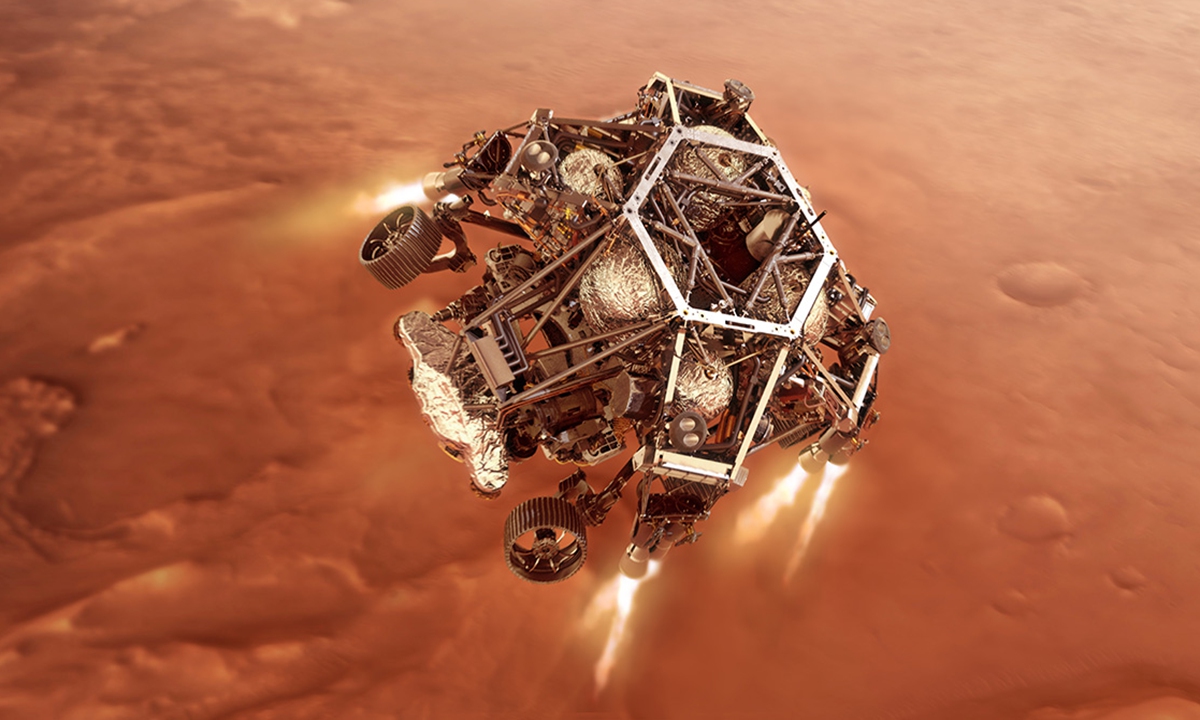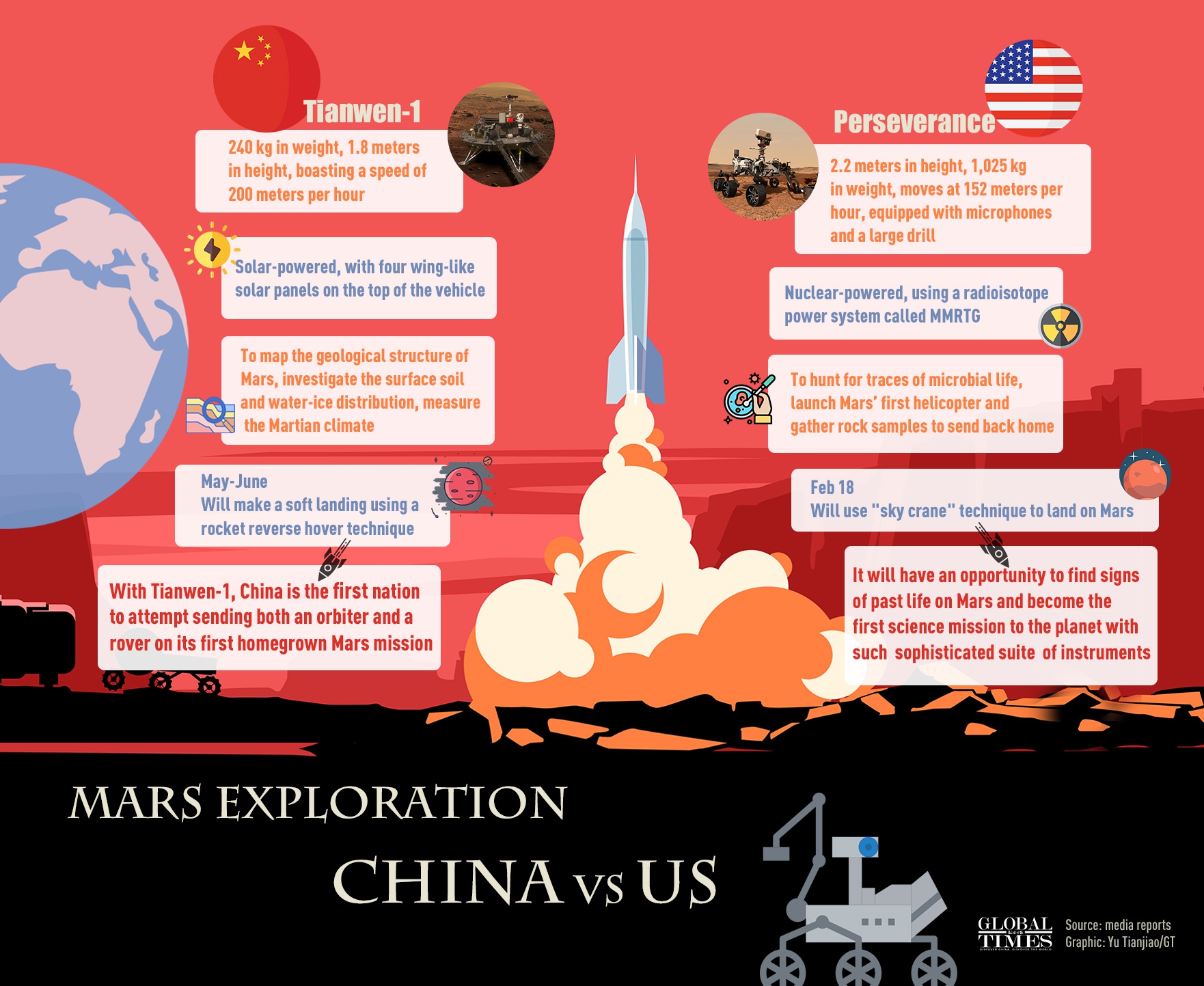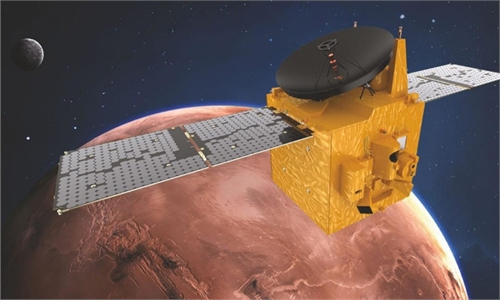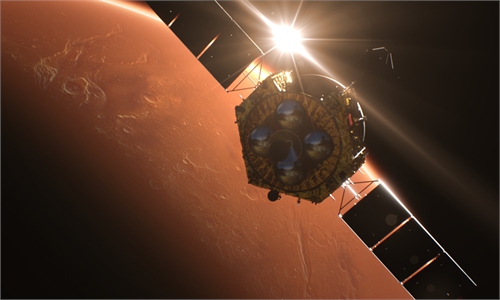SCI-TECH / AIR & SPACE
Following UAE, China, US latest country to reach Mars in 2021

Photo: twitter account of NASA's Perseverance Mars Rove
Following the Hope orbiter from the United Arab Emirates (UAE), and Tianwen-1 Mars probe from China, US NASA's Perseverance rover is homing in on the Red Planet and is expected to perform a "most precise" landing on Earth's neighbor on Thursday.Nicknamed "Percy," the US explorer - believed to be NASA's most advanced explorer to date - will land itself on Thursday. According to CNN, it has received commands and is ready to go, the mission team confirmed on Wednesday.
For the first time in human history, a fleet of three probes deployed from the UAE, China and the US set sail in July 2020 and took the seven-month interplanetary journey to Mars. The spacecraft from the UAE and China managed to enter Mars orbit on February 9 and 10, respectively.
Although the last to reach Mars, Percy will be the first to land, because the UAE craft is designed only to orbit and Tianwen-1 will spend three months or so orbiting before a planned landing in May or June.

Mars Exploration: China vs US
NASA has successfully landed on Mars eight times, and the American space agency is going to try to make it nine. According to NASA, Percy will be the agency's fifth rover on the Red Planet, if the landing is successful."Perseverance is NASA's most ambitious Mars rover mission yet, focused scientifically on finding out whether there was ever any life on Mars in the past," said Thomas Zurbuchen, an associate administrator for the Science Mission Directorate at NASA Headquarters in Washington DC.
"To answer this question, the landing team will have its hands full getting us to Jezero Crater - the most challenging Martian terrain ever targeted for a landing," Zurbuchen said.
Jezero is a basin where scientists believe an ancient river flowed into a lake and deposited sediment in a fan shape known as a delta. Scientists think that the environment was likely to have preserved signs of any life that gained a foothold billions of years ago - but Jezero also has steep cliffs, sand dunes and boulder fields, NASA said on its website on Tuesday.
Space enthusiasts from all over the world are holding their breath and counting down to this thrilling yet dangerous moment. Entry, decent and landing, or the EDL, is commonly known as "seven minutes of terror," highlighting the extreme difficulty.
Only half of all Mars exploration projects have conquered this stage of landing in human history, Pang Zhihao, a former researcher at the China Academy of Space Technology and space author, told the Global Times.
"Come on! Percy." Chinese netizens extended blessings and prayers on social media platforms for the success of the NASA spacecraft.
"We wish all the luck for a smooth landing of the explorer, and we are honored to be part of this 'Mars madness' that could make human history. Luckily, our Tianwen-1's got a front seat right on the spot to witness Percy's landing," said one comment on China's Twitter-like Sina Weibo.
"Unlike previous times, we are not just an audience. We are a participant gearing up to be next, ready to join the quest on Mars in just a few months," said another.
Tianwen-1, China's first Mars probe, successfully reached the Red Planet on Wednesday. After breaking into Mars gravity, it will begin orbiting the planet, during which it will examine the landforms and conduct a surface survey of Mars, especially the feasibility of its preset landing spot.
Responding to questions raised by space enthusiasts of why China decided to orbit the Red Planet for a few months rather than directly touching down as the US probe is supposed to do, Wang Ya'nan, chief editor of Beijing-based Aerospace Knowledge magazine, told the Global Times on Thursday that it is the only sensible choice for China.
"This is the first Mars exploration by China's spacecraft, while the US has already made eight successful attempts, during which it accumulated rich experience and data that supports the idea of a direct landing," Wang said.
There remains a technological gap between China and the US in this regard, but China is catching up at a remarkable speed, he noted.
"Having packed all three missions of orbiting, landing and roving in one go, China became the first country to do so, which proved its space capabilities are striding forward," Wang said.
Speaking of the tasks set for the two countries' Mars projects, experts reached by Global Times said that China aims to gain a general understanding of the planet's surface composition, environment and topography that would lay the foundation for more complex future missions, including sample retrieving.
The US is targeting something more precise. Perseverance is to touch down in Jezero Crater, which according to satellite imagery, bears the signs of once having held a giant lake.
In addition, the explorer will test the waters for sample collection techniques on the Martian surface, Wang added.




